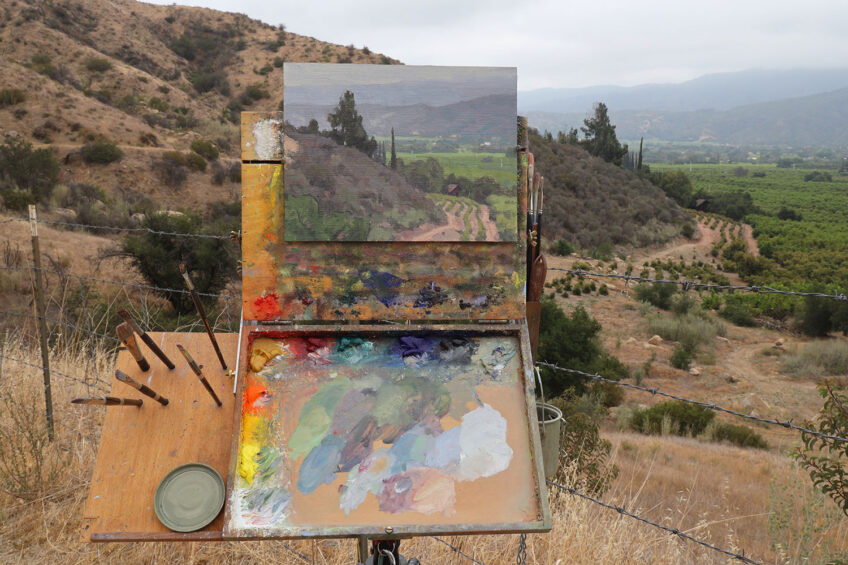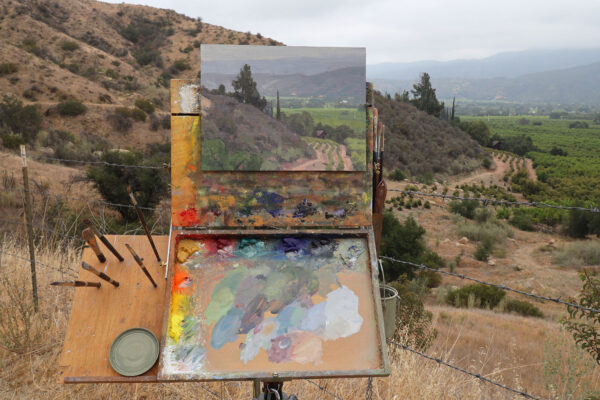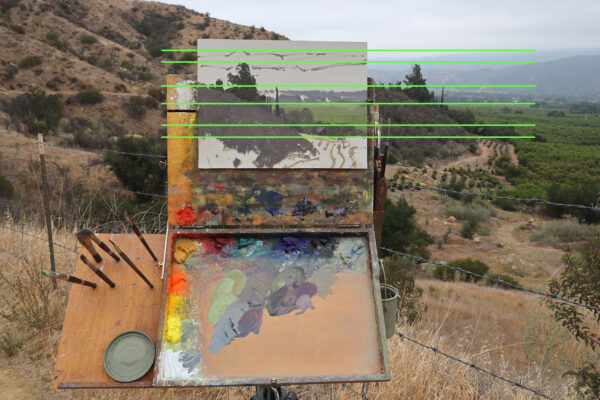If you’re an artist who struggles to get your shapes and proportions placed accurately while painting outdoors, try using the sight-size method.
You might say, “Who cares about getting the shapes right? I just love painting bright colors!” Remember that shape accuracy (you might call it “drawing” or “design” or “composition”) is the number-one most important principle in representation painting. You might paint beautiful colors and perfect values with fantastic brushwork and surface texture. But a poor design will likely distract from all that amazingness and greatly reduce your painting’s chance for success.
The Sight-Size Method
The sight-size method doesn’t work with every scene (more on that below), but it’s a great help for placing shapes correctly. Here’s how it works.
- Set up your easel so that your canvas is lined up horizontally with the view you’ve chosen to paint.
- While sketching the scene on your canvas, make horizontal comparisons between the elements in the landscape and your sketch. (See example photo.)
- Hold out your pencil or brush horizontally at arm’s length to help line things up.
Bonus Tip
This method can also be helpful for color matching. Since your painting and the actual landscape are visually right next to each other, you can more easily compare values and colors between the two.
When It Doesn’t Work
The sight-size method doesn’t work for every scene. You’ll have to choose a subject that’s an appropriate distance away. In other words, it may not work well for:
- Close-up views
- Scenes that are above or below your canvas (think tall-building cityscapes or deep canyons)
- Subjects that move, such as ocean waves or cloudscapes
- Situations when your canvas would have to be in direct sunlight in order to be next to your view (direct sunlight on your canvas while you paint can cause other problems, such as causing you to think the colors you’re painting are much lighter than they actually are)
But when you find a situation with an appropriate scene, give the sight-size method a try. For more inspiration, check out the work of artist Marc Dalessio. I’d say he has mastered the technique. His Instagram account shows lots of beautiful sight-size examples.



6 Responses
Michael Baum
Hey Dan, thanks for the tip. I will be trying it.
Jair Grandin
Grato pela importante lição, Abraços
David W. Mayer
Great tip Dan, BTW I’m now in Santa Fe new Mexico. Dave Mayer
Priscilla Evans
Cool!!! I will definitely try this when we go camping in the Sierras. Thanks Dan!
Kate
When that doesn’t work? I’d love some other methods. It is my single biggest issue with plein air. It relatively easy when you’re looking at a photo but when I’m outside it’s easy for a distort proportions without realizing it.
Dan Schultz
Hi Kate, I actually only rarely use the sight-size method myself. There are lots of instances when it just doesn’t work with the scene I want to paint. Two things that have been helpful to me when sight-size doesn’t work:
1. Small pencil sketches on a sketch pad. You can work out some compositional ideas quickly this way, then look at the sketch you like most as you draw the scene on your canvas.
2. Carry a ViewCatcher or other compositional viewfinder. (https://www.amazon.com/Color-Wheel-Artists-View-Catcher/dp/B001DKMZNG?th=1) This little tool can help you isolate just the part of the landscape you want to include in your painting. Hold it up and look at the landscape through it while you are drawing the scene on your canvas.
Beyond that, lots of repetition through many painting sessions will be helpful too.